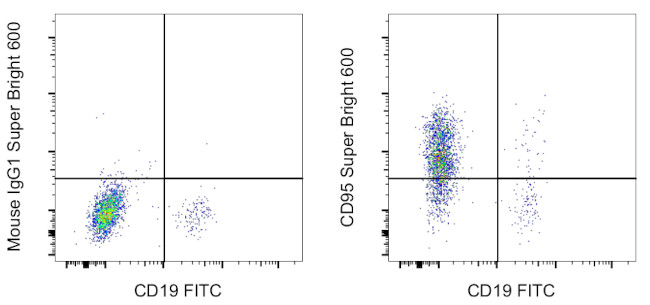Invitrogen
CD95 (APO-1/Fas) Monoclonal Antibody (DX2), Super Bright™ 600, eBioscience™
FIGURE: 1 / 2
CD95 (APO-1/Fas) Antibody (63-0959-42) in Flow


Product Details
63-0959-42
Species Reactivity
Published species
Host/Isotype
Recommended Isotype Control
Class
Type
Clone
Conjugate
Excitation/Emission Max
Form
Concentration
Purification
Storage buffer
Contains
Storage conditions
Shipping conditions
RRID
Product Specific Information
Description: The DX2 monoclonal antibody reacts with human CD95 (Fas, Apo-1), a 40-50 kDa member of the TNFR superfamily. CD95 is expressed by a broad range of hematopoietic and non-hematopoietic cells including monocytes, neutrophils, lymphocytes and fibroblasts. Interaction of CD95 on mature lymphocytes with its ligand (FasL) induces apoptosis and is thought to be important in peripheral tolerance. DX2 does not block binding of EOS9.1, another antibody specific for human CD95.
Applications Reported: This DX2 antibody has been reported for use in flow cytometric analysis.
Applications Tested: This DX2 antibody has been pre-diluted and tested by flow cytometric analysis of normal human peripheral blood cells. This may be used at 5 µL (0.25 µg) per test. A test is defined as the amount (µg) of antibody that will stain a cell sample in a final volume of 100 µL. Cell number should be determined empirically but can range from 10^5 to 10^8 cells/test.
Super Bright 600 is a tandem dye that can be excited with the violet laser line (405 nm) and emits at 600 nm. We recommend using a 610/20 bandpass filter. Please make sure that your instrument is capable of detecting this fluorochrome.
When using two or more Super Bright dye-conjugated antibodies in a staining panel, it is recommended to use Super Bright Complete Staining Buffer (Product # SB-4401) to minimize any non-specific polymer interactions. Please refer to the datasheet for Super Bright Staining Buffer for more information.
Light sensitivity: This tandem dye is sensitive to photo-induced oxidation. Please protect this vial and stained samples from light.
Fixation: Samples can be stored in IC Fixation Buffer (Product # 00-8222-49) (100 µL of cell sample + 100 µL of IC Fixation Buffer) or 1-step Fix/Lyse Solution (Product # 00-5333-57) for up to 3 days in the dark at 4°C with minimal impact on brightness and FRET efficiency/compensation. Some generalizations regarding fluorophore performance after fixation can be made, but clone specific performance should be determined empirically.
Excitation: 405 nm; Emission: 600 nm; Laser: Violet Laser
Super Bright Polymer Dyes are sold under license from Becton, Dickinson and Company.
Target Information
FAS (Fas, CD95, APO-1) is a 46 kDa transmembrane glycoprotein that functions as a cell death receptor of the TNFR (tumor necrosis factor receptor) superfamily. FAS also exists in a soluble form that weight approximately 26kDa. Stimulation of FAS results in aggregation of its intracellular FAS-associated death domains (FADD), formation of the death-inducing signaling complex (DISC) and activation of caspases. The auto-proteolytic processing of the caspases in the complex trigger a downstream cascade that leads to apoptosis. FAS has been shown to activate NF-kappaB, MAPK3/ERK1, MAPK8/JNK, and is involved in transducing the proliferating signals in normal diploid fibroblast and T cells. At least eight alternatively spliced transcript variants encoding seven distinct isoforms have been described. The isoforms lacking the transmembrane domain may negatively regulate the apoptosis mediated by the full-length isoform. The Fas/Fas ligand system has been shown to play a role in a number of human diseases such as AIDS, hepatitis and cancer. It is also assumed that induction of apoptosis through FAS ligand pathway is predominantly involved in anti-viral immune responses.
For Research Use Only. Not for use in diagnostic procedures. Not for resale without express authorization.
How to use the Panel Builder
Watch the video to learn how to use the Invitrogen Flow Cytometry Panel Builder to build your next flow cytometry panel in 5 easy steps.
Bioinformatics
Protein Aliases: Apo-1 antigen; APO-1 cell surface antigen; Apo-1 Fas; Apo1 antigen; apoptosis antigen 1; apoptosis signaling receptor FAS; Apoptosis-mediating surface antigen FAS; CD95; CD95 antigen; Fas (TNF receptor superfamily, member 6); Fas AMA; FASLG receptor; OTTHUMP00000020045; OTTHUMP00000020046; OTTHUMP00000020051; OTTHUMP00000059646; TNF receptor superfamily member 6; Tumor necrosis factor receptor superfamily member 6; tumor necrosis factor receptor superfamily, member 6
Gene Aliases: ALPS1A; APO-1; APT1; CD95; FAS; FAS1; FASTM; TNFRSF6
UniProt ID: (Human) P25445
Entrez Gene ID: (Dog) 486469, (Human) 355

Performance Guarantee
If an Invitrogen™ antibody doesn't perform as described on our website or datasheet,we'll replace the product at no cost to you, or provide you with a credit for a future purchase.*
Learn more
We're here to help
Get expert recommendations for common problems or connect directly with an on staff expert for technical assistance related to applications, equipment and general product use.
Contact tech support

